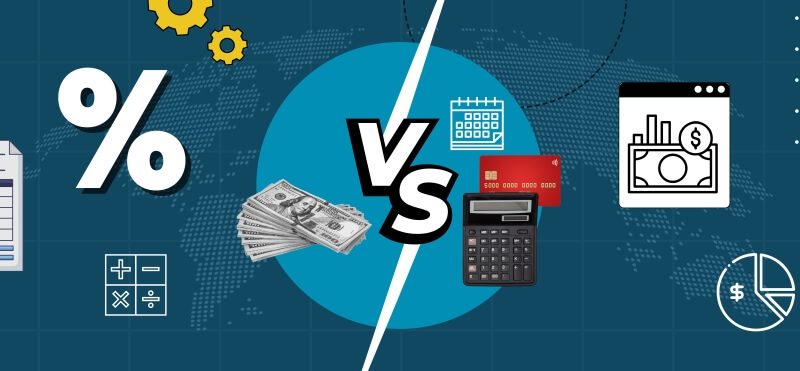If you run a business, you know that your sales transactions or payments must be recorded in your books, that’s obvious. But did you know that there are 2 different ways of recording financial data?
Read on to learn more about accrual and cash-based accounting methods. Find out what the rules, benefits, and limitations of each of those methods are and how accounting methods apply in the real world of business.
Contents:
1. Financial accounting basics: types and rules of accounting methods
- Cash basis method = things ‘count’ when the money moves
- Accrual basis method = things ‘count’ when they start moving
2. Which approach to accounting is best for a business?
- Things to know about accounting methods in business
- Things to consider before choosing an accounting method
Financial accounting basics: types and rules of accounting methods
There are two approaches to recording financial data: accrual-basis accounting and cash-basis accounting.
Basically, these are two ways to associate data with other data; two sets of ‘rules’ on when things should ‘count’ toward the financial picture. In bookkeeping, things ‘count’ when the transaction is dated. So, whenever that date falls inside the period being looked at, that transaction is ‘counting’ toward the numbers you are seeing. Obviously, how things are dated should be consistent across transactions so that data relationships and what a report is actually saying remain clear.
Deciding the logic behind HOW dates should be assigned for any transaction is where the differences between Cash Basis and Accrual Basis accounting comes into play and other accounting basics for small businesses and individuals.
Cash basis method = things ‘count’ when the money moves
Transactions are recognized when things happen with payment.
So for instance, a sale will not be recognized as income until the payment for that sale is received. Likewise, a purchase will be recognized as an expense when it is actually paid for. If a sale or purchase is only partially paid for then only that part is recognized as a sale or expense.
What does this mean practically? The date associated with a transaction under the cash basis should be the date that movement or exchanges of money take place.
The benefits of cash-based accounting
Because you are not counting events until they actually occur with regard to money, you are not counting money before you actually receive or release it. So viewing the sales you had in a prior month will more closely reflect the amount of actual deposits seen that month.
Cash basis reporting makes it easier to see what is happening with the flow of actual cash in your business over time. It demonstrates whether or not how you are spending and collecting actual money is a sustainable way to keep your business healthy, and, potentially, how best to reinvest and optimize that money in order to grow.
But, viewing a business with the Cash Basis method also has its downside.
The limitations of cash-based accounting
Depending on when ‘the money happens’ means the true short-term position or even overall value of the company might be over or understated. How much this affects the look of the business depends upon how far away sales and expenses are from payment of those sales and expenses.
Cash-based accounting: sales example
For example, a lot of my own work as an accountant and consultant is with independent restaurant and bar owners. For the vast majority of these businesses, payment for what they sell is received immediately! People pay for their meals as they receive the food.
But it is just as true that most often the products a restaurant or bar uses to make the items it sells are purchased on ‘terms’ – meaning they don’t have to pay for those products for usually 10, 15, or 30 days. It is easy to see how the sales of a product often happen in a different month or period than the purchase of the goods used to make that product. Sometimes the difference between these two events even spans different years.
In a cash-basis report, the first year might seem great with most of the money from the sales of product, while the following year will claim all the expenses when those bills come due. It is easy to see why the ‘health’ of the business in either year might be misleading.
Accrual basis method = things ‘count’ when they start moving
Transactions are recognized when the debt is incurred or the sale is generated.
So for instance, a sale becomes income when the sale is made. Likewise, a purchase becomes an expense when it is bought. When the sale or purchase is paid for, whether it was all at once or in installments, in 30 days or three months – it doesn’t matter.
What does this mean practically? The date associated with a transaction under the accrual basis should be the date that the revenue and expenses were generated.
The benefits of accrual-based accounting
Because you are counting events when they actually begin having an impact on the business, you are usually keeping earnings and the related expenses in relationship to each other. So viewing the sales you had in a prior month will more closely reflect all the costs associated with fulfilling that sale.
Accrual basis reporting makes it easier to see what is happening with the actual profitability of a business over time. It demonstrates whether or not expenses for sales are outstripping the sales themselves for any given period. It lets you see if a business is sustainable and which areas of a business might be most profitable.
But, like Cash Basis, the Accrual Basis method also has its downside.
The limitations of accrual-based accounting
Viewing sales and expenses by when they are generated does not allow a picture of what cash flow issues a business might currently have going on. Not to mention, counting sales when they are generated means declaring income that has not actually been received yet, or expenses that have not actually been paid out yet.
Accrual-based accounting: sales example
For example, under the accrual basis the food and beverage invoices for my clients are bought before the final invoice is due. But the paying out of those expenses and the paying in of the sale might still not happen in the same year. In an accrual basis report, the sale will appear in the same period as the expenses, but it also means those profits will be claimed and those costs claimed before the money is actually spent AND before all the product is actually sold.
Which approach to accounting is best for a business?
Here are some things to know and guidelines to consider before you choose the accounting method that’s right for your business.
Things to know about accounting methods in business
- A business may choose either method to report information for tax purposes, but generally must choose one and stick to it. Changing is possible, but it will cause a lot of trouble.
- Some company structures are required to report on either cash or accrual basis for tax purposes.
- The setup in the accounting data needs to be able to reflect whatever option has been chosen for tax purposes, but it does not have to ONLY reflect that basis.
- Some accounting systems do allow you to switch between cash and accrual reporting for internal reporting purposes.
Things to consider before choosing an accounting method
- Typically, being able to effectively switch between cash and accrual views of the business inside a company’s reports means that data needs to be entered on an accrual basis whenever possible.
- When only the dates of payment are recorded and no bills or invoices are used, it typically means there is little difference between the two OR that the data might not be available to generate accrual basis reports.
- For businesses that do not grant payment terms to customers or have payment terms with vendors, cash-basis reports may look very similar to accrual-basis reporting.
Accounting methods: Closing thoughts
The two accounting methods are a fundamental part of how you record your transactional data. Knowing the benefits and the limitations of each method can help you pick the method that fits the way you do business and know what is required of your business at tax time.
Understanding both accounting methods, no matter which you choose, can open up the possibilities that each method brings. Grasping the differences between these points of view can give you a better grasp of the health of your business and even reasons for its challenges. When you are equipped with these insights, you are able to actively participate in decisions about the right accounting method with your trusted accounting professional.
Incorporating an understanding of What is invoicing in accounting into this context can provide a deeper insight into how transactions are recorded and managed in each method.

.png)





I found this blog post on accounting methods is very informative and I appreciate the insights you shared. look forward to reading more from you in the future.